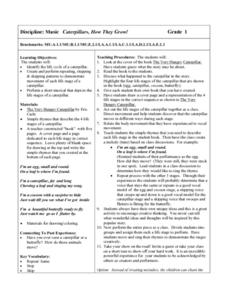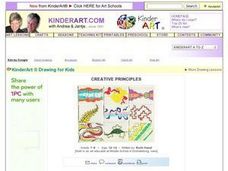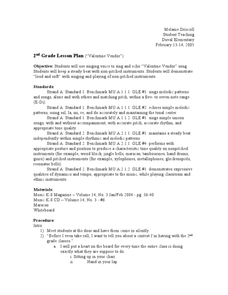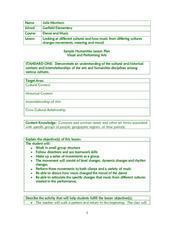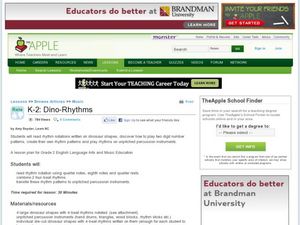Curated OER
Kodaly Beat Lesson
Introduce rhythmic beat and melodic beat with a upbeat activity that asks young musicians to clap the beat to their favorite nursery rhyme. To introduce the rest beat, class members use small drums or other percussion instruments to play...
Curated OER
Music Lesson Plan for Teaching Children with (Severe) Autism
Here's a packet of music activities designed specifically for children with autism. Kids learn greeting, echo, and repertory songs, as well as rhythmic patterns to play rhythm instruments.
Classics for Kids
"Mars" from The Planets
Gustav Holst's The Planets provide young musicians an opportunity to examine how composers can create a suite: a collection of smaller pieces grouped to explore a single topic. After listening to "Jupiter," they examine "Mars" in detail,...
Curated OER
Using Rhythm to Teach Patterns and Directions
Introduce young learners to line dancing. Here are some simple movement patterns to teach them. First teach, repeat, and repeat again without music. Then when they have a pretty good grasp of the movement patterns, add music and practice...
Fun Music Company
Treasure Island Clues: Rhythm
Designed for rhythm level 1, the two games in this packet ask young musicians to identify the number of beats represented by a series of notes and notations, and then to use those numbers to answer a music trivia question.
Curated OER
Music: Caterpillars, How They Grow!
Put on some music and get moving as a way to represent the life cycle of a caterpillar. Kids listen to the story The Very Hungary Caterpillar, discuss the life cycle, then create vocal expression that represent each stage of the cycle....
Curated OER
Native American Music: Section 2
Take a look into the many facets, purposes, and styles of Native American music. Each slide in this well-organized presentation provides clear introductory information on the forms and functions of American tribal music. Use it to...
Hawaiʻi State Department of Education
Rhythm Patterns
Fractions can be tricky. Why not have kids think of fractions like they think of eighth, quarter, and half notes? In teams, the class creates four-measure patterns with their percussion instruments. They need to explain their rhythm...
BBC
The Nutcracker by Tchaikovsky
Over the course of six lessons, scholars try their hand at composing and dancing after a thorough examination of the famous ballet, The Nutcracker, by Tchaikovsky. Participants watch and discuss the performance of two dances, create and...
Concordia College Archives
History and Musical Aesthetics
What are the musical elements that characterize a school's fight song or its alma mater? Class members listen to examples of fight songs and alma maters from various schools, play a listening game, and then create a list of the...
Curated OER
CREATIVE PRINCIPLES
Jr. high learners review the basic principles of design (balance, unity, movement, rhythm, pattern, contrast and emphasis) by watching a video by Gerald Brommer. Then they provide "aerobic exercise" for the right side of their brains by...
Curated OER
Reading Basic Music Notes
First graders develop skills in reading music notes. In this reading music instructional activity, 1st graders clap and chant rhythm patterns and learn music vocabulary. Students also match patterns by listening to the teacher perform...
Curated OER
You've Got Rhythm
Students study the rhythm value of a half note, quarter note, whole note, and eighth note. They stamp a rhythm pattern and create a clay animation which demonstrates note value.
Curated OER
Grade 2: Music/Valentine's Day
Play and sing a Valentine's song with your second graders. They'll follow along allow as you demonstrate how to sing and keep a steady beat on non-pitched percussive instruments. While the music lesson has a Valentine theme, that theme...
Curated OER
Singing a round
Kids use their hands, bodies, and voices to explore the musical concept of a round. They say vegetable words while stomping and clapping out a rhythm in unison and then in a round. They then sing a round while maintaining a steady beat....
Berklee College of Music
Create Your Own Afro-Latin Groove
The backbone of Latin American music is the beat! Young musicians work on blending Afro-Latin rhythms and beat patterns before incorporating the major pentatonic, minor pentatonic, and blues scales in their own compositions.
Curated OER
The Tango
Fourth graders explore the music of Buenos Aires as they hear and then dance the Tango. They practice basic Tango rhythm, learn to sing the song, "Any Turkey can Tango," then practice a few Tango-riffic dance steps with a partner. What a...
Curated OER
Transferring Rhythmic Patterns From Music to Movement
Students identify and demonstrate movement elements in relation to musical notation. They clap to rhythms, beat on drums, match musical notes to speech patterns and use the rhythms of the their names to create a dance.
Curated OER
Investigation - Patterns/Functions
Students explore one-to-one correspondence. Through activities, students examine rhythm and patterns. From the patterns discovered, students create a visual representation of the pattern with blocks.
Curated OER
Line and Pattern
Young scholars create a silhouette of a simple figure and repeat it to create a pattern drawing with rhythm.
Smithsonian Institution
The Birth of an Icon: Learning and Performing the Origins of the Drum Set and Early Jazz Drumming in New Orleans, Louisiana
Bass drum, snare drum, tom-toms, cymbals. Perched behind their drum sets, wielding their drum sticks and wire brushes, drummers lay the grove and are the heartbeat of a band's performance. A dynamic lesson introduces young musicians to...
Curated OER
Looking at different cultures and how music from differing cultures changes movements, meaning and mood
Each of the three dance lessons included here will get your class moving. The first lesson allows learners to explore how music and movement differ in meaning depending on cultural context. Lesson two gives them an opportunity to create...
Curated OER
Native American Music and Dance Activity
Young scholars demonstrate keeping steady beat through practice exercises and stepping to the beat using instruments such as conga drums, tambourines and rhythm sticks.
Curated OER
K-2: Dino-Rhythms
Second graders read rhythm notation and combine four-beat rhythms. In this rhythms lesson plan, 2nd graders read quarter notes, eighth notes, and quarter rests in rhythms that are written on dinosaur shapes. They clap, snap, or stamp out...







